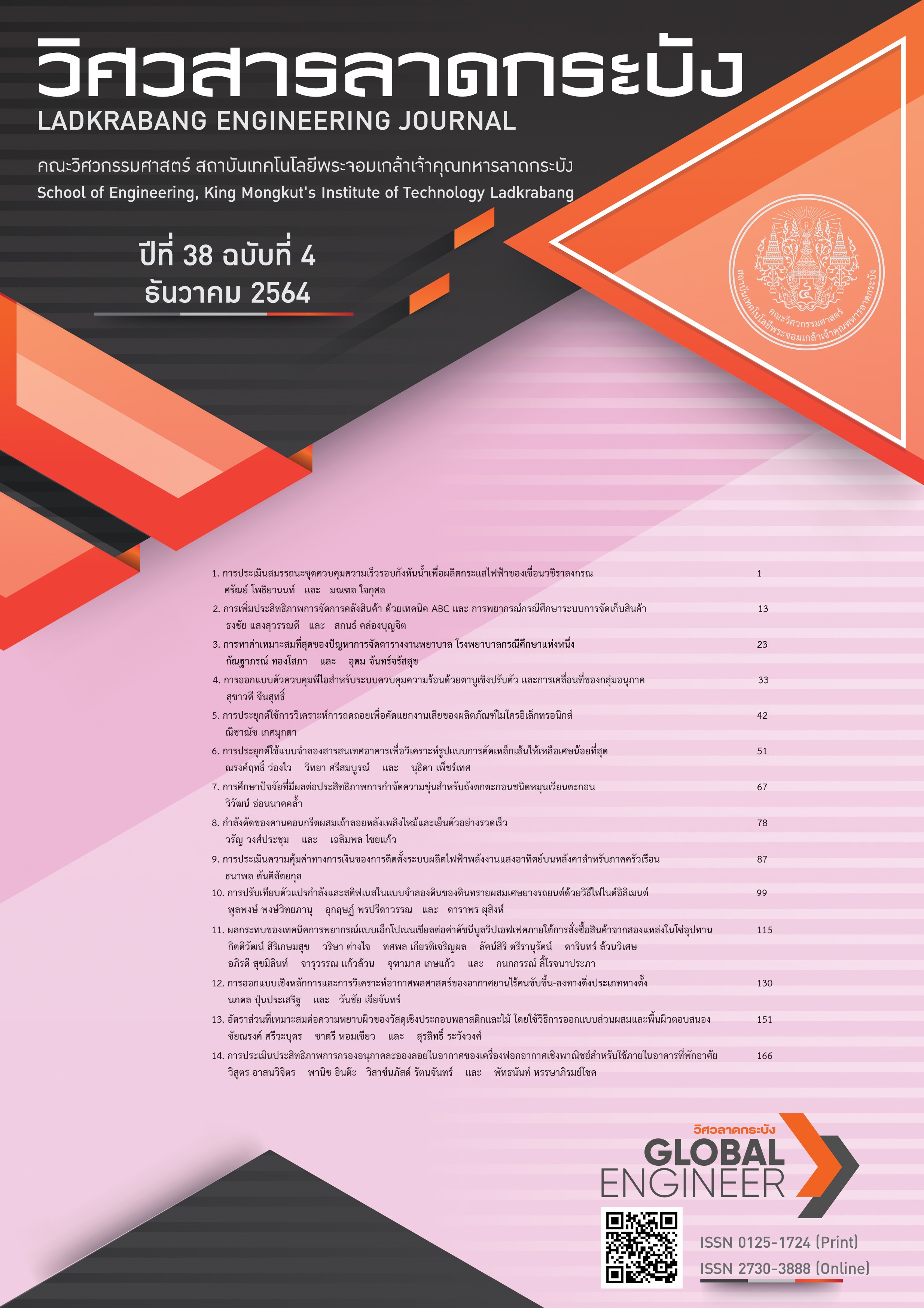การประยุกต์ใช้แบบจำลองสารสนเทศอาคารเพื่อวิเคราะห์รูปแบบการตัดเหล็กเส้นให้เหลือเศษน้อยที่สุด
คำสำคัญ:
อาคารคอนกรีตเสริมเหล็ก, เศษเหล็กน้อยที่สุด, แบบจำลองสารสนเทศอาคาร, แบบจำลองโปรแกรมเชิงเส้นบทคัดย่อ
ปัญหาที่พบในงานก่อสร้างอาคารคอนกรีตเสริมเหล็กคือปริมาณเศษเหล็กที่สูญเสียเป็นจำนวนมากจากการใช้รูปแบบการตัดเหล็กเส้นที่ไม่มีประสิทธิภาพส่งผลให้ค่าใช้จ่ายของโครงการสูงขึ้นและการขาดดุลทางเศรษฐกิจของประเทศจากการนำเข้าเหล็กเส้นที่เพิ่มขึ้นในแต่ละปี งานวิจัยนี้นำเสนอการเชื่อมโยงข้อมูลเหล็กเส้นจากแบบจำลองสารสนเทศอาคารกับแบบจำลองโปรแกรมเชิงเส้นเพื่อวิเคราะห์รูปแบบการตัดเหล็กเส้นให้เหลือเศษน้อยที่สุด การศึกษาแบ่งออกเป็นสามขั้นตอน ขั้นตอนแรกคือส่งออกข้อมูลเหล็กเส้นจากแบบจำลองสารสนเทศอาคาร ขั้นตอนที่สองคือการวิเคราะห์รูปแบบการตัดเหล็กเส้นให้เหลือเศษน้อยที่สุด และขั้นตอนที่สามคือการนำข้อมูลการตัดเหล็กเส้นกลับเข้าสู่พารามิเตอร์ของชิ้นส่วนแบบจำลองสารสนเทศอาคาร ผลการศึกษาที่ได้จากงานวิจัยนี้จะเป็นประโยชน์กับอุตสาหกรรมก่อสร้างในด้านการช่วยลดปริมาณเศษเหล็กเส้นที่เหลือจากกระบวนการตัดให้น้อยลง ส่งผลให้การใช้ทรัพยากรมีประสิทธิภาพมากขึ้นและลดค่าใช้จ่ายในงานก่อสร้าง ผลของจำนวนเศษเหล็กเส้นที่น้อยลงยังช่วยลดปัญหาขยะที่เกิดขึ้นจากงานก่อสร้างและปัญหาการขโมยเศษเหล็กเส้นโดยคนงานก่อสร้าง นอกจากนี้งานวิจัยนี้มีคุณค่าทางวิชาการในแง่การพัฒนาแบบจำลองโปรแกรมเชิงเส้นที่สามารถค้นหารูปแบบการตัดเหล็กเส้นที่สามารถลดปริมาณเศษเหล็กเส้นที่เหลือจากการตัดได้มากขึ้นอย่างมีนัยยะสำคัญ โดยสามารถใช้คำนวณปัญหาที่มีเหล็กเส้นความยาวมาตรฐานที่นำมาตัดหลายความยาว และการเชื่อมโยงข้อมูลการตัดเหล็กเส้นกลับไปยังกับแบบจำลองสารสนเทศอาคารทำให้ลดระยะเวลาและความผิดพลาดในการทำงาน
References
Iron and Steel Intelligence Unit, “Thailand Steel Outlook 2020,” Iron and Steel Institute of Thailand, Bangkok, Thailand, Jul. 2021 [Online]. Available: https://iiu.isit.or.th/th/reports/Yearly%20Report.aspx
S. Chinanuwatwong, “Reducing Waste from Cutting Reinforcing Steel in Construction Projects,” Kasetsart Journal Natural Science, vol. 34, no. 4, pp. 526–535, 2000, doi: https://li01.tci-thaijo.org/index.php/anres/article/view/240397/163946
H. Dyckhoff, “A Typology of Cutting and Packing Problems,” European Journal of Operation Research, vol. 44, no. 12, pp. 145–159, 1990, doi: 10.1016/0377-2217(90)90350-K
M. Gradisar, K. Miroljub, R. Gortan and J. Joze, “A Sequenntial Heuristic Procedure for One-Dimensional Cutting,” European Journal of Operational Research, vol. 114, no. 13, pp. 557–568, 1999, doi: 10.1016/S0377-2217(98)00140-4
J. Coffman, E. M. Garey and D. S. Johnson, “Approximation Algorithms for Bin-Packing: An Updated Survey,” Algorithm Design for Computer System Design, vol. 284, pp. 49–106, 1984, doi: 10.1007/978-3-7091-4338-4_3
Y. Cui and Y. Yang, “A heuristic for the one-dimensional cutting stock problem with usable leftover,” European Journal of Operational Research, vol. 204, no. 12, pp. 245–250, 2010, doi: 10.1016/j.ejor.2009.10.028
C. R. Goncalo, A. S. Sergio and M. Marlos, “Modified Greedy Heuristic for the one-dimensional cutting stock problem,” Journal of Combinatorial Optimization, vol. 41, no. 12, pp. 657–674, 2021, doi: 10.1007/s10878-021-00695-4
R. Vahrenkamp, “Random Search in the One-Dimensional Cutting Stock Problem,” European Journal of Operation Research, vol. 95, no. 11, pp. 191–200, 1996, doi: 10.1016/0377-2217(95)00198-0
V. Benjaoran, “Trim Loss Minimization for Construction Reinforcement Steel with Oversupply Constrints,” Journal of Advanced Management Science, vol. 1, no. 13, pp. 313–316, 2013, doi: 10.12720/joams.1.3.313-316
V. Benjaoran and Bhokha, “Three-Step Solution for Cutting Stock Problem of Construction Steel Bar,” KSCE Journal of Civil Engineering, vol. 18, no. 115, pp. 1239–1247, 2014, doi: 10.1007/s12205-014-0238-3
A. Porwal and N. Hewage, “Building Information Modeling–Based Analysis to Minimize Waste Rate of Structural Reinforcement,” Journal of Construction Engineering and Management, vol. 138, no. 18, pp. 943–954, 2012, doi: 10.1061/(ASCE)CO.1943-7862.0000508
M. Mangal and J. C. Cheng, “Automated Optimization of Steel Reinforcement in RC Building Frames Using Building Information Modeling and Hybrid Genetic Algorithm,” Automation in Construction, vol. 90, pp. 39–57, 2018, doi: 10.1016/j.autcon.2018.01.013
M. T. H. Khondoker, “Automated Reinforcement Trim Waste Optimization in RC Frame Structures Using Building Information Modeling and Mixed-Integer Linear Programming,” Automation in Construction, vol. 124, pp. 103599, 2021 doi: 10.1016/j.autcon.2021.103599
The Association of Siamese Architects under Royal Patronage, Thailand BIM Guideline, Plus press Company Limited, 2015, ch. 1–2, pp. 2–14
I. Autodesk, “Dynamo Developer Resources.” dynamobim.org. https://dynamobim.org/. (accessed Aug. 1, 2021)
T. E. Seghier, Y. W. Lim, M. H. Ahmad and W. O. Samuel, “Building Envelope Thermal Performance Assessment Using Visual Programming and BIM, based on ETTV Requirement of Green Mark and GreenRE,” International Journal of Built Environment and Sustainability, vol. 4, no. 3, pp. 227–235, 2017, doi: 10.11113/ijbes.v4.n3.216
D. Team, “DiRoots Connecting the Dots,” diroots.com. https://diroots.com/revit-plugins/revit-to-excel-sheetlink/. (accessed Aug. 1, 2021)
Downloads
เผยแพร่แล้ว
How to Cite
ฉบับ
บท
License
บทความที่ได้รับการตีพิมพ์เป็นลิขสิทธิ์ของคณะวิศวกรรมศาสตร์ สถาบันเทคโนโลยีพระจอมเกล้าเจ้าคุณทหารลาดกระบัง
ข้อความที่ปรากฏในบทความแต่ละเรื่องในวารสารวิชาการเล่มนี้เป็นความคิดเห็นส่วนตัวของผู้เขียนแต่ละท่านไม่เกี่ยวข้องกับสถาบันเทคโนโลยีพระจอมเกล้าเจ้าคุณทหารลาดกระบัง และคณาจารย์ท่านอื่นๆในสถาบันฯ แต่อย่างใด ความรับผิดชอบองค์ประกอบทั้งหมดของบทความแต่ละเรื่องเป็นของผู้เขียนแต่ละท่าน หากมีความผิดพลาดใดๆ ผู้เขียนแต่ละท่านจะรับผิดชอบบทความของตนเองแต่ผู้เดียว






